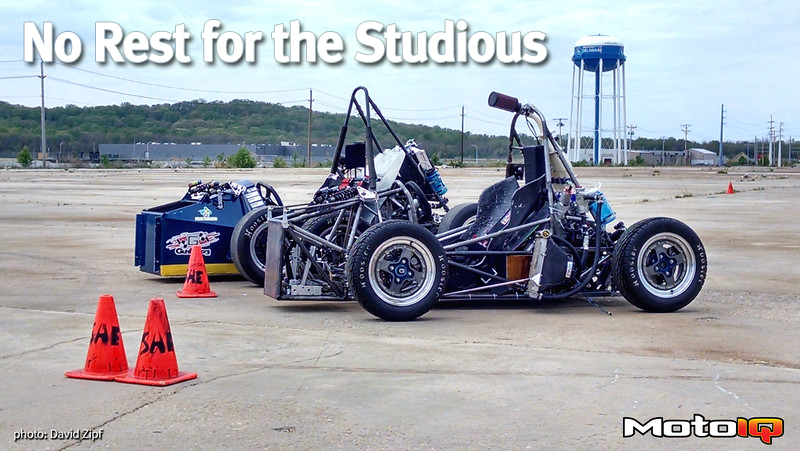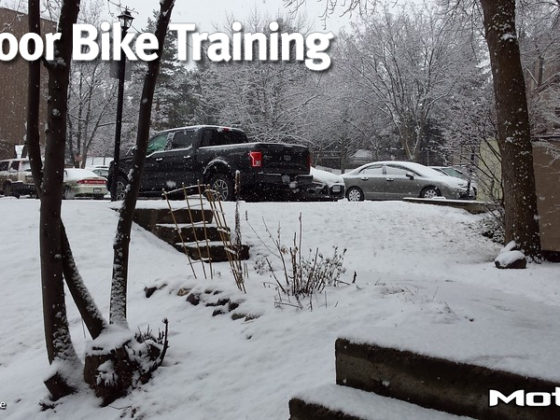,
 The fuel tank is the gold covered box next to the radiator. You can see how challenging the packaging situation was. The fuel tank is custom made and houses a Yamaha R6 pump in the bottom. The factory barbed fitting on the pump was machined off and replaced with an NPT to A/N swivel elbow to get the tank and pump as low as possible and point the fuel lines in the right direction. Without this fitting, the tank would have sat too high for the seat to fit (remember the fuel line has to make a 90 degree turn which takes up about 2 more inches than the elbow does). The big clear hose is the filler neck. It’s flexible and fuel safe and doubles as our sight tube. An aluminum section is clamped on at the top to hold a gas cap. The flex is very useful as it allows us freedom to route the filler neck. We had to wrap the lower half with some header wrap to prevent it from melting since it’s very close to the header. The fuel system is all plumbed with Earl’s ProLite 350 nylon braided line in -6 A/N size. MotoIQ has used this line many times before because it’s light, doesn’t chafe like stainless steel, and is super easy to cut. An Aeromotive AFPR is used to regulate fuel pressure. The fuel system is a return style and the return fitting is an Earl’s bulkhead fitting screwed into the rear side of the tank. The tank is filled with anti-slosh foam to prevent fuel starvation in cornering. The tank holds around gallon and a half of gas, just enough to finish the 20 km Enduro. Fuel is 93 octane pump gas. Since this engine is internally stock, there’s no reason to run race fuel or E85. In fact, with this tune we could even run on 89 octane and be fine, but the lowest grade of gas offered at competition is 93 (race gas and E85 are also offered).
The fuel tank is the gold covered box next to the radiator. You can see how challenging the packaging situation was. The fuel tank is custom made and houses a Yamaha R6 pump in the bottom. The factory barbed fitting on the pump was machined off and replaced with an NPT to A/N swivel elbow to get the tank and pump as low as possible and point the fuel lines in the right direction. Without this fitting, the tank would have sat too high for the seat to fit (remember the fuel line has to make a 90 degree turn which takes up about 2 more inches than the elbow does). The big clear hose is the filler neck. It’s flexible and fuel safe and doubles as our sight tube. An aluminum section is clamped on at the top to hold a gas cap. The flex is very useful as it allows us freedom to route the filler neck. We had to wrap the lower half with some header wrap to prevent it from melting since it’s very close to the header. The fuel system is all plumbed with Earl’s ProLite 350 nylon braided line in -6 A/N size. MotoIQ has used this line many times before because it’s light, doesn’t chafe like stainless steel, and is super easy to cut. An Aeromotive AFPR is used to regulate fuel pressure. The fuel system is a return style and the return fitting is an Earl’s bulkhead fitting screwed into the rear side of the tank. The tank is filled with anti-slosh foam to prevent fuel starvation in cornering. The tank holds around gallon and a half of gas, just enough to finish the 20 km Enduro. Fuel is 93 octane pump gas. Since this engine is internally stock, there’s no reason to run race fuel or E85. In fact, with this tune we could even run on 89 octane and be fine, but the lowest grade of gas offered at competition is 93 (race gas and E85 are also offered). The cooling system uses a Yamaha YFZ450R radiator. This may seem a bit small and it is. However we had a few countermeasures for this. First, this radiator actually came off our 2011 car. It already had a high flow fan and custom made carbon fiber shroud attached to it. This would ensure that cool air is always moving across our radiator. The fan is temperature controlled by the AIM dash. The two water bottles are catch cans. The left side holds engine coolant and the right catches blow by from the engine. The rules state all catch cans must hold 1 quart of boiling liquid. Lexan water bottles fit the bill perfectly, are light, cheap, and can be bought in UD colors at the student store. A swirl pot doubles as the fill point and since it is the highest part of the cooling system, is also well placed to bleed out air bubbles.
The cooling system uses a Yamaha YFZ450R radiator. This may seem a bit small and it is. However we had a few countermeasures for this. First, this radiator actually came off our 2011 car. It already had a high flow fan and custom made carbon fiber shroud attached to it. This would ensure that cool air is always moving across our radiator. The fan is temperature controlled by the AIM dash. The two water bottles are catch cans. The left side holds engine coolant and the right catches blow by from the engine. The rules state all catch cans must hold 1 quart of boiling liquid. Lexan water bottles fit the bill perfectly, are light, cheap, and can be bought in UD colors at the student store. A swirl pot doubles as the fill point and since it is the highest part of the cooling system, is also well placed to bleed out air bubbles.
Our second countermeasure was using an oil cooler. No, not for cooling oil but for cooling water! The GSXR engine has a built in water to oil heat exchanger and has separate water lines running to and from this cooler (in the bike, they route directly back into the radiator, which is mounted in front of the engine where our seat and driver are). The water from the Suzuki cooler is piped into this Mocal external oil cooler (which was lying around in the workshop) and then routed back into the main cooling circuit. It actually worked! The cooler has a computer fan bolted to the back to pull air through the core. This is a cumbersome cooling solution, but only requires off the shelf parts to work. Because of the factory oil cooler, coolant routing either requires a bunch of tees and hoses to circulate around the engine, or an expensive custom radiator. We chose the former option.

We could have used a GSXR radiator, but two things stopped us: one, they’re absurdly expensive, even used. Two, they are too big. All parts of the car must be within the envelope of the tires and rollhoop. The Suzuki radiator is too wide to fit between the chassis and tire. We could mount it behind the engine, but this requires a tall firewall (that not only protects the driver but also blocks airflow to said radiator) and would greatly raise the CG of the car. We did this on the BHR13 and had overheating problems on very hot days, despite using an aftermarket EF Civic radiator. The metal panel just behind the muffler houses the ECU, fuse panel, and ambient pressure and temperature sensors for the car. It also has the tipover switch from the bike placed in it. This way nobody can start the engine if the panel is lowered. The actuator for the active exhaust is the black box mounted on the outside of the cover.



